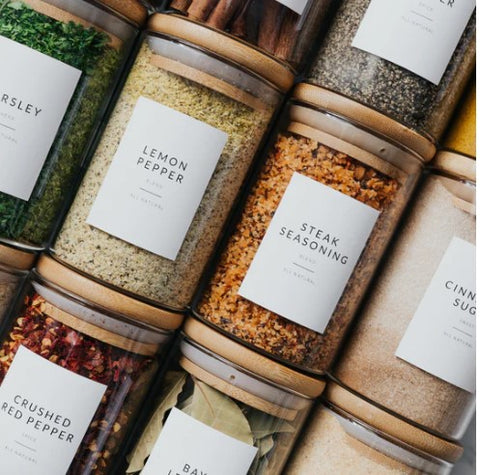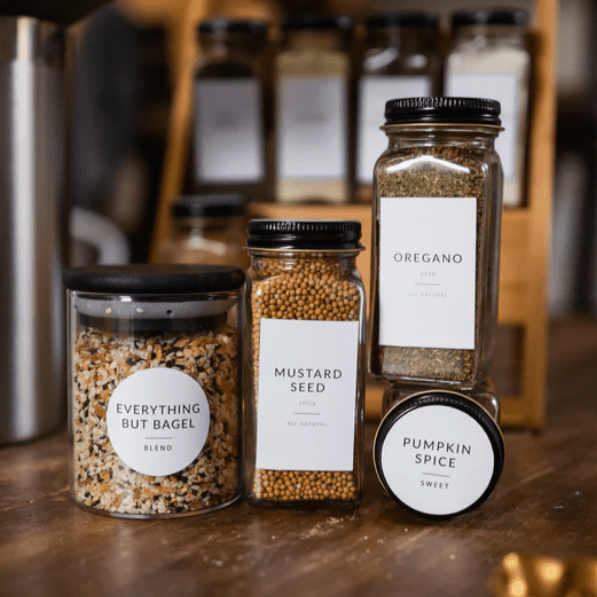Not sure if you’re grabbing oregano or basil? Stop the spice search before it starts.
Proper labeling keeps your spice cabinet tidy so you can flavor your dishes without wasting time searching for what you need.
Quick links:
Quickly check expiration dates
Grab our easy-to-use spice labels to organize your cabinets and racks in a snap!
Let’s highlight 6 of the main benefits of labeling your spices.
Save time
The first, and in some ways most beneficial aspect of a spice labeling system is that it allows you to find the right jars in a jiffy.
You don't have to shuffle through a jumbled cabinet of similar containers when cooking or baking. One quick look at the label and you'll know where to find the ingredient you need.
Whether you’re after cumin for tacos or oregano for pasta sauce, clear labels will make it easy to find spices and flavor your dishes without frustrating searches.
A labeling system also saves you time when putting spices away after a shopping trip. Identify the right spot for your latest spice purchases with a properly labeled cabinet or rack.
Take a look at our blog post and find out all the benefits of labeling your pantry system!
Prevent flavor mix-ups
Spice jars help prevent those sometimes disastrous flavor mix-ups while cooking. It is so easy to grab garlic powder instead of onion powder or celery salt—they all look the same!
With a quality labeling system, you'll avoid these annoying spice confusions. One glance at a marked jar prevents the possibility of adding the wrong ingredient to your dish.
For example, if you reach for the curry powder but grab chili powder by accident, you may end up with an unexpectedly fiery meal. Accurate labels allow you to differentiate between similar dried spices and herbs. No more guessing which one is which!
Allow you to see what is in stock
An organized, labeled spice drawer or cabinet doesn't just help as you cook. It is also a handy tool when you are writing out your shopping lists for kitchen restocks.
At a glance, you can easily assess your current spice supply. No more opening multiple unlabeled containers to take inventory. Simply note which spices appear to be running low and pick up a refill on your next grocery run.
Spice labels are great for recipe planning as well. Take a look at your spice stash and find out exactly what you have on hand for cooking or baking.
Keep spices organized in storage
A proper labeling system helps keep your spice collection neatly organized. Whether you store spices in a cabinet, drawer, shelf, or spice rack, labels prevent a cluttered mess.
Clearly marked airtight containers make it easy to spot where spices belong. Ground spices stay fresh when properly sealed, and glass spice jars allow you to easily see contents without having to open every container.
Organic spices and spice blends will last longer when stored away from direct sunlight, heat sources, and humidity. A well-organized spice collection kept in a cool, dark place keeps flavors fresh and your sanity intact.
Rather than shuffling through disorganized cabinets, quality labels guide you to the cinnamon, paprika, or any herb you need. Your spice collection remains neatly organized instead of having containers strewn about your shelves.
Check out our natural bamboo spice jar collection! With an 8.5 oz volume, hand-painted bamboo lid, and silicone ring for an airtight seal, your precious spices will stay fresh and organized.
Make your kitchen look tidy
A properly labeled spice system makes your kitchen look clean and orderly rather than chaotic and messy.
Proper labeling makes your shelves look intentionally styled. Similar-sized jars with matching labels create a sense of harmony instead of clutter. A tidy spice collection makes the entire kitchen look pleasant and put together. Grab a set of our minimalist spice labels, or our sunshine spice labels to add some flare to your spice collection.
Consider coordinating your spice rack labeling with the rest of your kitchen style. Use colors and fonts that match for a cohesive look. Let your spice storage enhance the aesthetic design of the space.
Guests in your kitchen will admire the tidy rows of attractive containers. Clear labels indicate you value organization and care about the appearance of your cooking space. A neatly arranged spice drawer or cabinet elevates the entire room.
Let you quickly check expiration dates
A proper labeling system allows you to monitor spice freshness by clearly marking purchase dates or opening dates directly on jar labels. At a glance, you can spot spices that may be past their peak.
Rotation becomes seamless with visible expiration information. Simply move older spices up front while shifting newer additions toward the back.
Clear expiration labels let you identify stale spices to replace before you use them. You'll never need to wonder how long a certain bottle has been sitting unused. The label makes it instantly clear.
Visible organization also simplifies regular spice purging. Spices that have exceeded their freshness date can be tossed and replaced. Maintain the great taste of your dishes by keeping your spice collection up-to-date.
Promote household harmony
A clearly labeled spice collection doesn’t just help in the kitchen—it also enables smoother interactions between multiple cooks.
When roommates or family members can easily access the spices they need for recipes, it prevents annoyance. No more desperately shuffling through disorganized spices for a missing ingredient! Labels identify key spices, blends, and herbs at a glance.
Labeled spice storage makes sharing simpler for all cooks. Labels distinguish specialty ingredients from common spices.
For instance, custom labels like “Sriracha spice mix—extra spicy” or “Sandy’s Italian seasoning” promote clarity on content and ownership. A good labeling system avoids blend mix-ups and arguments in the kitchen.
Proper labeling also eliminates duplicate purchases of spices already available, which helps save money, and saving money leads to harmony in the household!
If you’re interested in saving money while getting organized, read our article about how to organize your pantry on a budget.
Benefits of labeling spices FAQ
What are the labeling requirements for spices?
There are no specific legal labeling requirements for spices sold directly to consumers. However, any claims made on labels for spices regarding organic certification or non-GMO verification must meet regulations.
Some best practices are to mark names, expiration or purchase dates, lot codes, and any allergy information if the facility handles common allergens like dairy or nuts.
What are the three rules for food labeling?
The three key rules for proper food labeling as required by the FDA for food manufacturers are:
- Ingredient list in order from most to least by weight
- Clearly state if the food contains any of the major allergens like dairy, eggs, wheat, etc.
- Accurately represent the serving size and nutritional data like calories per serving for the food product
Following these rules allows consumers to make informed choices.
What does the FDA require on food labels?
The FDA requires food products to display certain nutritional information like calories, serving size, sugars, sodium content, and breakdown of fats. Labels must also state all ingredients in order of predominance and call out major food allergens.
How do I make my own spice labels?
To make your spice jar labels, start by compiling a list of all your spices and spice blends to assess which labels are needed. Choose sticky labels, chalkboard labels, waterproof tags, or opt for a combination. Neatly type or write out the names of spice containers to affix to your glass bottles or spice jars. You can also add the best-before date and use-by date.
Are spices regulated by the FDA?
The FDA provides guidelines and regulations regarding the production, processing, and safety of spices as food products, but does not oversee or manage aspects such as spice names, quality classification, or labeling requirements.
How do you classify spices?
Spices can be classified in various ways such as by flavor profile (earthy, pungent, sweet) by origin (berries, seeds, barks), by application (e.g. baking or savory), or even by intensity rating from mild to very spicy.
Are all spices the same quality?
No, spices can vary greatly in quality and purity. Factors such as growing methods, processing techniques, and even storage conditions can affect the strength and quality of flavors.
How do you keep track of spices?
To easily keep track of spices you have in stock, keep an up-to-date written grocery list. Label each spice container clearly with uniform labels stating the name, purchase date, and expiration date to aid organization. Store backup spices separately from spices for daily use to quickly assess stock at a glance.
Are spice racks worth it?
Spice racks or a well-organized kitchen cabinet are worth the storage space. Mounted racks or slide-out shelves bring accessibility to spice jars stored out of sight in cabinets. Angled displays keep jar labels facing forward to identify contents at a glance and locate ingredients for your favorite recipes.
What is the best way to store spices for a long time?
The best way to store spices long term and maintain freshness is to purchase spices in smaller quantities that will be used up faster once opened. Decant extras into clean, airtight glass spice containers to store them away from light, heat, and moisture.
How do you keep spices from molding and drying out?
To prevent drying out and molding herbs, store spices in clean, air-tight glass containers. You can also use reused jars or bottles. Metal tins protect spices from light exposure.
Use waterproof labels to mark contents and purchase dates for monitoring freshness. Wipe lids thoroughly to remove food residue before sealing. Store spices away from heat, humidity, and sunlight, and ensure your cabinet space is clean and dry.






